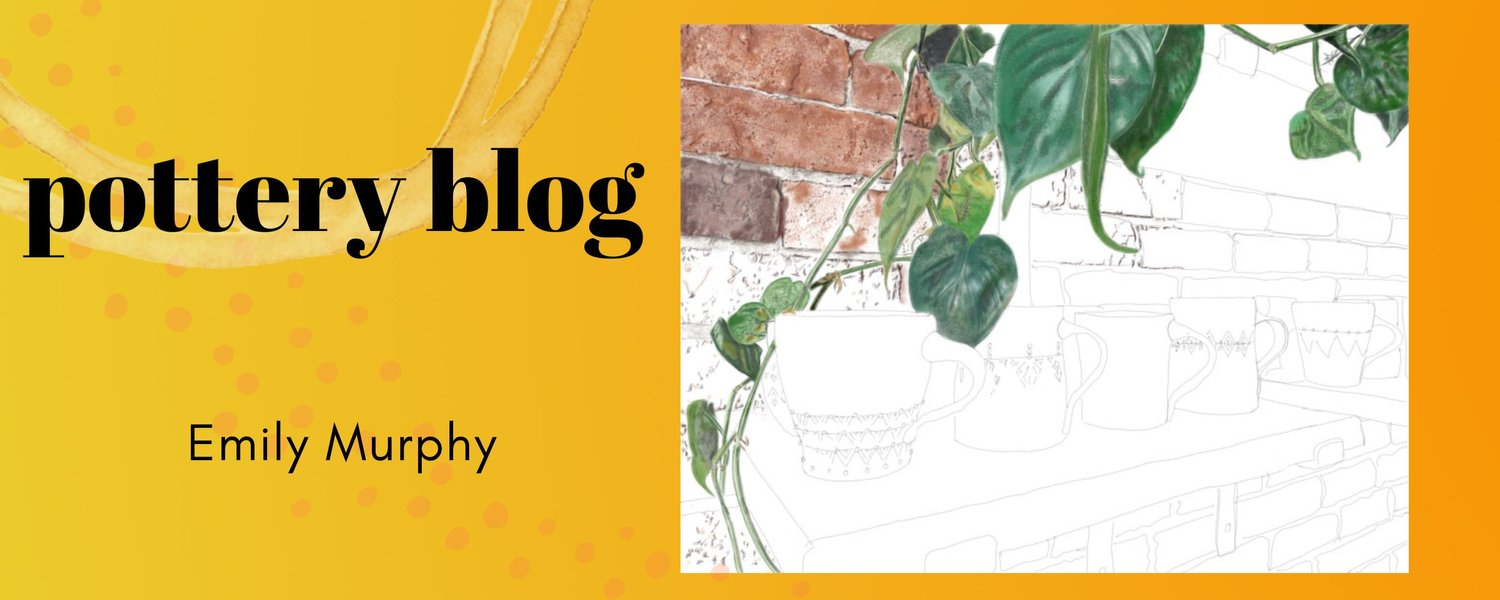how-to: make your own set-up for photographing pottery
There are so many parts to being a potter besides throwing pots. Photographing pots is one of the big ones. Since we're in such an online world right now, it is more important than ever to have good photos taken of your work than ever before. Whether it's for documenting, sharing on blogs/facebook/website, selling directly, promotional materials or applying to shows. And if those photos aren't great- it can really reflect poorly on your work. It makes it hard to really *see* the work.

One of the things I really wanted to prioritize when I started building my studio was that I needed a place that was easy to take photos. So I set about designing a photo booth that could be mounted to the wall and be opened up easily when it was time to take photos.
I keep tweaking the set-up, but here is where it is at right now:
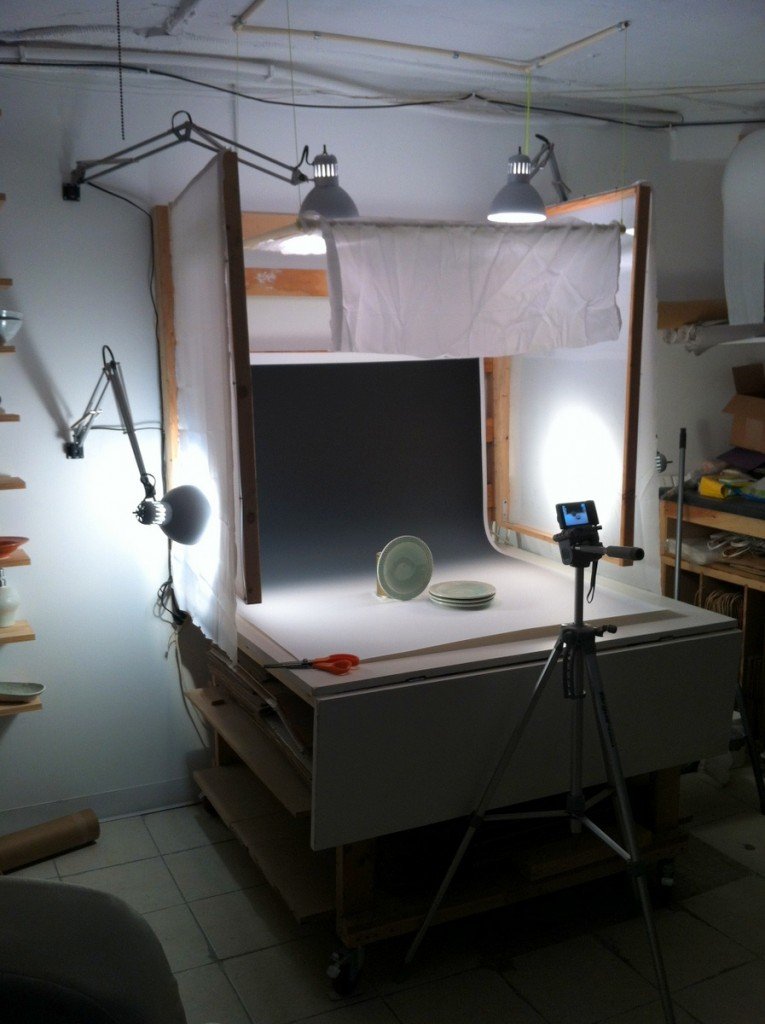
Here is what the framework looks like:
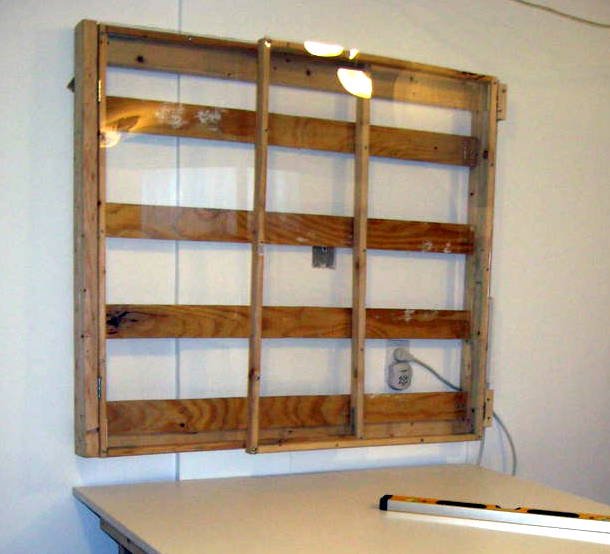
A couple of things to note:

Thediffuserfor the top lights is built out of pvc. And then nylon string is used as a pulley system. In the below photo it shows a frosted plastic- but I am not using that anymore. I am actually using the nylon shower curtain liner instead. But this photo makes it easier to see how the diffuser is designed so I used it instead of a newer photo of the set-up.
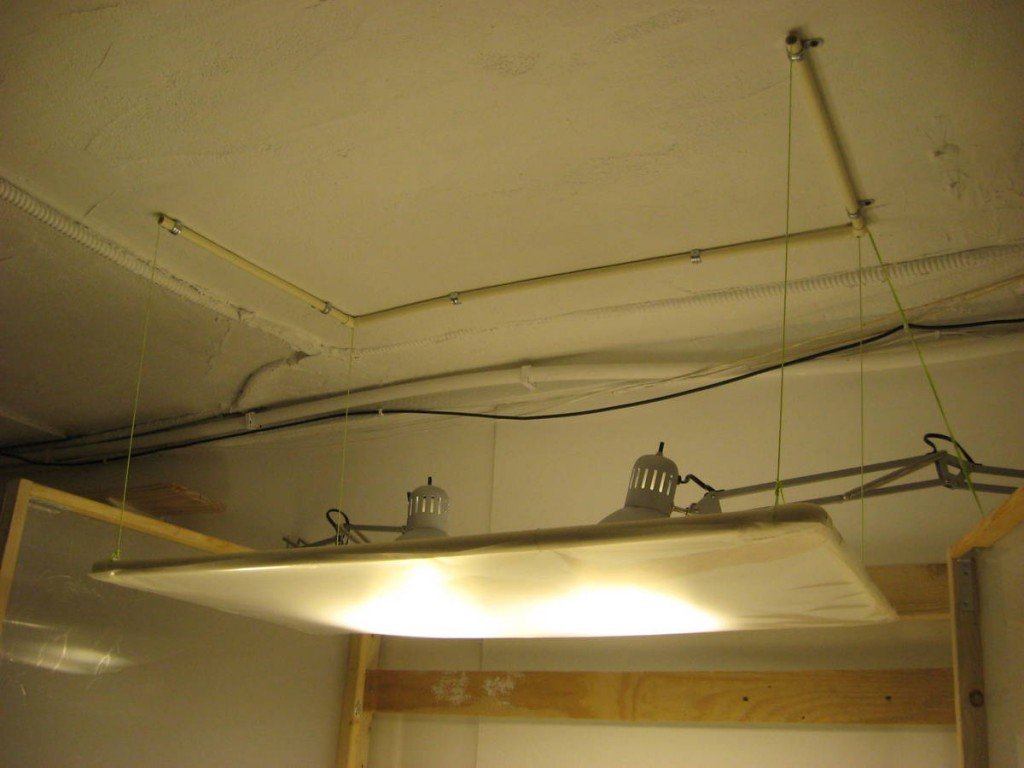
When I need prop up a plate, platter, etc..., I find something that is pretty heavy around and then use a piece of clay where the prop comes into contact with the piece for a little extra friction. The backdrop is very easily scratched and marked so it is important to put something protective down under it. Like this piece of clean packing foam. A hard brick works well, but I didn't have one handy. During this photo shoot I used a new can of stain. I momentarily put down the brand new, perfectly clean can without the foam at first and it left a ring. I didn't even notice until later. Arg. I posted this on Facebook and it was funny to hear what other people used to prop up when photographing pots!
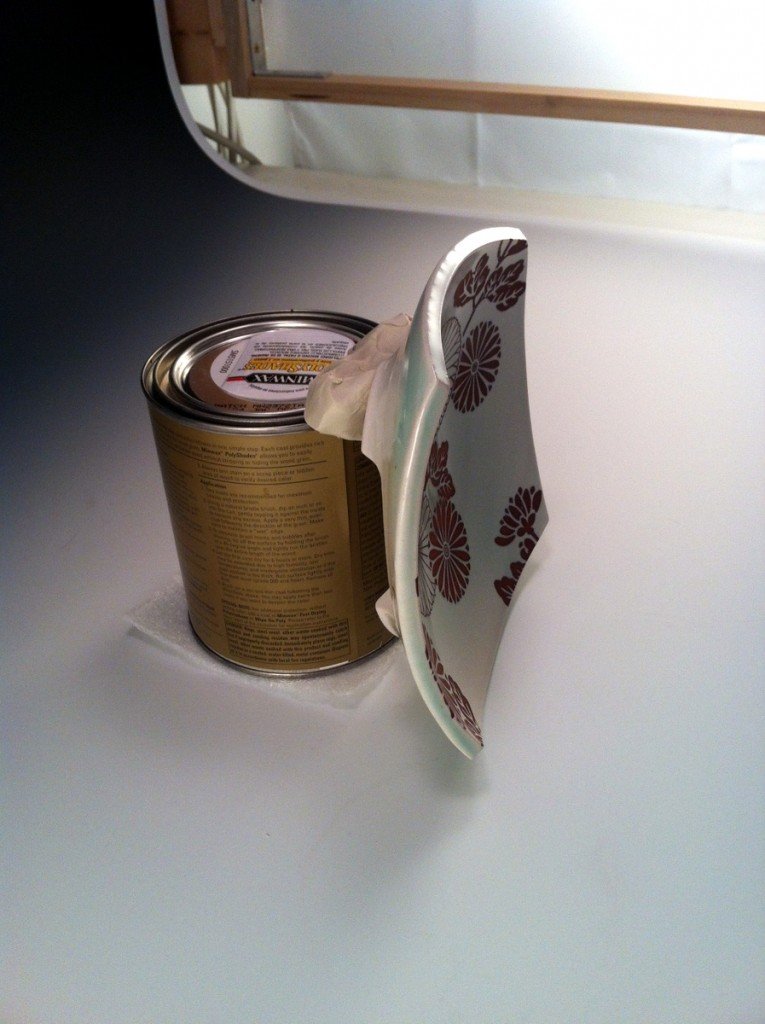
Here is an example:

These are the bulbs that I use. I think I got them after doing a photography workshop- but I can't actually remember. Either way, they do the job. They seem to have a nice white color to them.

I use a graduated background to photograph my pots on. It's really a way to get the look of using a grey backdrop with the lighting set-up in a particular way but in kind of a short-cut way. (see the link to Michael Coffee's set-up below for the real deal.) The material of the background is vinyl and there is a seamless non-glare coating sprayed onto it. It is very easily scratched and marked up. No matter how careful you are. They aren't cheap and need to be replacedoccasionally. But I think it is worth it, still.This is what I am using:Veritone graduated background - O9: white to black size: 42" x 62". You can get away with the smaller size if you are just photographing small pieces (like mugs). But if you want to photograph something larger like a platter, or a row of mugs, it is just too small. There is another brand, Adorama, that you can get through Amazon. It looks the same as the Veritone, but I have not tried it yet. I also take some photos using either white poster board or illustration board and some reclaimed wood. I really love the way it turns out.
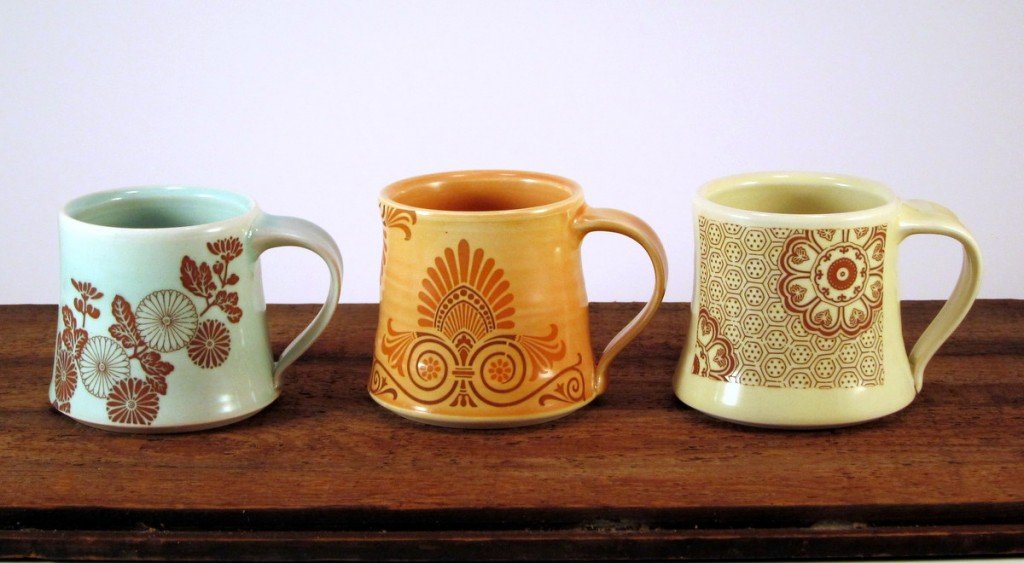
To actually do the photographing, I use a tripod. And I really love my camera,a Canon s95. It's a sophisticated point and shoot camera. It has a large image stabilizer like a dslr camera. There is a newer version of this camera, the Canon s100, Canon s110. But the version that I have seems to have the highest ratings, by far.
One little gaget that I have that I suggest for anyone with a digital camera and a wi-fi connection: the Eye-Fi memory card. It's a memory card (comes in a variety of formats and sizes to fit most cameras) that will send your images wirelessly to anywhere that you have set up: your computer, an online backup, etc... Mine is set-up to go to Picasa Web Albums for an online backup and also to my laptop. And then I get an email and text whenever photos have been uploaded. When I first started using it, it was like "finally! my photos are liberated from my camera!" Between the Eye-fi card and the camera on my phone, it has really made it super easy to give regular updates to my Emily Murphy Pottery Facebook Page. (note: some of the newer digital cameras actually come with wi-fi now like the s100/s110, so this isn't needed.)
When it comes to doing simple photo editing, I use Picasa. It is super simple to use. It is free. A couple of my favorite features from Picasa are:
I did some searching and asking around and came up with a list of other blog posts and articles about photographing your pottery that you might find helpful:
If there is a link that you think I should add, or anything else that would be helpful/ clarifying, just let me know!
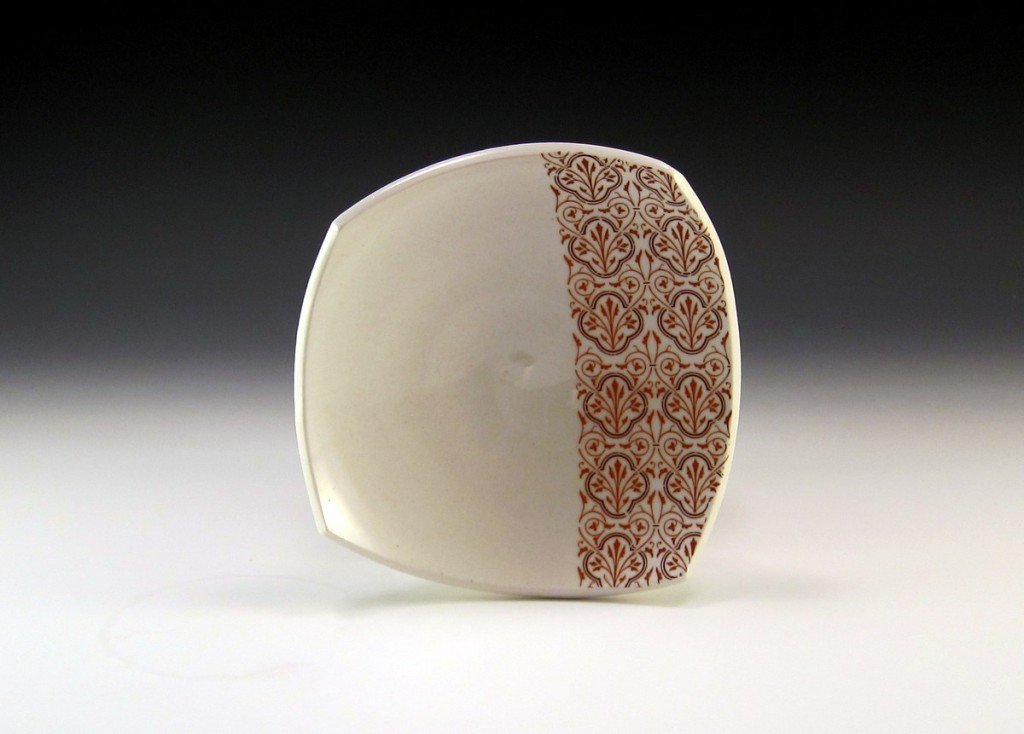

One of the things I really wanted to prioritize when I started building my studio was that I needed a place that was easy to take photos. So I set about designing a photo booth that could be mounted to the wall and be opened up easily when it was time to take photos.
I keep tweaking the set-up, but here is where it is at right now:

Here is what the framework looks like:

A couple of things to note:
- There is a power strip mounted on the side for easy plugging in of lights- and the ability to turn them all on and off in one place.
- The "walls" that fold out have plexi-glass on them. This helps give the frame structure without cross braces. I added a frosted coating to the plexi. It isn't enough of a diffuser. I went to a photographing pottery workshop and it was suggested to use a shower curtain liner- the fabric ones that are 100% polyester. Different fabrics can cast a yellow or bluish tone when light shines through it. Using this type of fabric means the light will be white. I bought mine at Target. It seems to do the trick quite well.
- The swing arm lamps are from Ikea. You can clamp them onto a table or screw the bracket onto the wall. I love having the lights on swing arms. It means I can move them around quickly and easily to adjust to the pot I am photographing at the time.
- The slats on the back are not actually against the wall. There is a space behind them. They are there so I can clip a backdrop with binder clips are different heights.
- I always take my photos at night. I have 3 windows in my studio and I don't have blackout shades on them so in order to control the lighting on the pots- I have all the lights off except for the photo booth lights and only photograph at night.

Thediffuserfor the top lights is built out of pvc. And then nylon string is used as a pulley system. In the below photo it shows a frosted plastic- but I am not using that anymore. I am actually using the nylon shower curtain liner instead. But this photo makes it easier to see how the diffuser is designed so I used it instead of a newer photo of the set-up.

When I need prop up a plate, platter, etc..., I find something that is pretty heavy around and then use a piece of clay where the prop comes into contact with the piece for a little extra friction. The backdrop is very easily scratched and marked so it is important to put something protective down under it. Like this piece of clean packing foam. A hard brick works well, but I didn't have one handy. During this photo shoot I used a new can of stain. I momentarily put down the brand new, perfectly clean can without the foam at first and it left a ring. I didn't even notice until later. Arg. I posted this on Facebook and it was funny to hear what other people used to prop up when photographing pots!

Here is an example:

These are the bulbs that I use. I think I got them after doing a photography workshop- but I can't actually remember. Either way, they do the job. They seem to have a nice white color to them.

I use a graduated background to photograph my pots on. It's really a way to get the look of using a grey backdrop with the lighting set-up in a particular way but in kind of a short-cut way. (see the link to Michael Coffee's set-up below for the real deal.) The material of the background is vinyl and there is a seamless non-glare coating sprayed onto it. It is very easily scratched and marked up. No matter how careful you are. They aren't cheap and need to be replacedoccasionally. But I think it is worth it, still.This is what I am using:Veritone graduated background - O9: white to black size: 42" x 62". You can get away with the smaller size if you are just photographing small pieces (like mugs). But if you want to photograph something larger like a platter, or a row of mugs, it is just too small. There is another brand, Adorama, that you can get through Amazon. It looks the same as the Veritone, but I have not tried it yet. I also take some photos using either white poster board or illustration board and some reclaimed wood. I really love the way it turns out.

To actually do the photographing, I use a tripod. And I really love my camera,a Canon s95. It's a sophisticated point and shoot camera. It has a large image stabilizer like a dslr camera. There is a newer version of this camera, the Canon s100, Canon s110. But the version that I have seems to have the highest ratings, by far.
One little gaget that I have that I suggest for anyone with a digital camera and a wi-fi connection: the Eye-Fi memory card. It's a memory card (comes in a variety of formats and sizes to fit most cameras) that will send your images wirelessly to anywhere that you have set up: your computer, an online backup, etc... Mine is set-up to go to Picasa Web Albums for an online backup and also to my laptop. And then I get an email and text whenever photos have been uploaded. When I first started using it, it was like "finally! my photos are liberated from my camera!" Between the Eye-fi card and the camera on my phone, it has really made it super easy to give regular updates to my Emily Murphy Pottery Facebook Page. (note: some of the newer digital cameras actually come with wi-fi now like the s100/s110, so this isn't needed.)
When it comes to doing simple photo editing, I use Picasa. It is super simple to use. It is free. A couple of my favorite features from Picasa are:
- If you have a slightly crooked photo, you can correct it with the straighten tool.
- the "I'm feeling lucky" button does a great job of correcting the contrast and color. I use this with most photos.
- The crop feature allows you to set the ratio of your crop so you can do things like make an Etsy banner.
- You can create collages simply on it.
- You can add text to an image. Collage plus text = an easy flier for a sale!
I don't stress out too much over every little detail of a photo. I am naturally inclined to obsess over that sort of thing. And if I gave into that inclination, I would never get anything else done. So I usually do some simple cropping and contrast correction and leave it at that. And Picasa is perfect for that.
So there is the info my photo set-up. It's just one of an infinite number of ways you could set one up. I love my set-up. It makes it easy to take photos and then basically takes up no storage space when it is not in use. It suits me, my work and my space well.
I did some searching and asking around and came up with a list of other blog posts and articles about photographing your pottery that you might find helpful:
- Jeff Campana: Turning Pots into JPegs, Part One
- Michael Coffee: Shots of Pots on the Cheap and LowTech
- Warren Fredrick:A Natural Light Studio Setup
- June Perry: My Photo Setup
- Handmadeology: Taking Photos of Your Ceramic Pottery
- John Hesselberth:Taking High-Quality Photos of Your Work
- Joy Tanner: Photographing Your Own Work
- GlazeFixer.com: How to Photograph Your Pottery
- In Words and Pictures: Crafting Better Photos With an Easy DIY Light Box
- John Tilton: John's Photography Setup
- Cynthia Guajardo: Photographing Ceramic Jewelry, A Photoshop Tutorial
- Making it Lovely: Product Photography (part two)
If there is a link that you think I should add, or anything else that would be helpful/ clarifying, just let me know!

